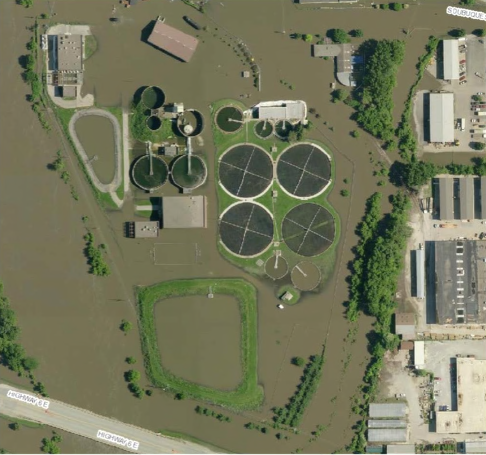EDA Investment Relocates Wastewater Treatment Plant, Protects Iowa City Water Supply from Future Floods

In June of 2008, surges in the Iowa River leading into Iowa City prevented access to the downtown area causing significant impact to the local business community. The river remained above flood stage for 32 consecutive days halting commerce and transportation in the region for weeks. The flood damage resulted in hundreds of millions of dollars in public and private damage in Iowa City.
The most significant damage was to the city’s main wastewater treatment plant. The North Wastewater Treatment Plant was overwhelmed with the flood waters, resulting in untreated wastewater being released downstream. The flooding disaster halted the treatment plant’s ability to support local businesses so city officials decided to relocate the North Wastewater Treatment Plant to the site of the South Wastewater Treatment Plant, which is located outside of the floodplain.
To get the necessary funding needed to complete the project, city officials reached out to EDA to apply for disaster recovery funding.
In 2010, EDA awarded $22 million to Iowa City to relocate the city’s North Wastewater Treatment Facility out of the Iowa River floodplain.
“The magnitude of the disasters of 2008 was so great it required significant federal investment in our recovery,” said Doug Elliott, Executive Director, East Central Iowa Council of Government. “EDA’s nimbleness set it apart from other federal agencies. EDA representatives worked directly with communities to determine the greatest needs and the most appropriate role for EDA assistance. The flexibility of EDA funding allowed the agency to support a comprehensive approach toward recovery and long-term resiliency, from staffing through recovery coordinators, to infrastructure through public works. Throughout Iowa, and especially in the ECICOG region, the goal was to ‘build back better.’ EDA was a key partner in bringing that goal to reality.”
Since EDA’s investment in 2010, the relocation of North Wastewater Treatment Plant has addressed the local community’s need for wastewater treatment during significant flooding events, making it a shining example of how EDA can support local disaster recovery efforts in the wake of tremendous destruction.
The decommissioning of the North Treatment Plant also supported the development of a large park that provides access to the river and recreational activities that is part of a comprehensive redevelopment effort called the Riverfront Crossing District. This master-planned redevelopment engaged other federal agencies such as EPA’s Sustainable Communities programs and has resulted in more than $160 million in private investment including Class-A offices, restaurants, commercial and retail spaces, and multi-family/MXD buildings.
In 2018, EDA received $587 million in supplemental funding available for disaster recovery grants in areas impacted by Hurricanes Harvey, Irma, and Maria and wildfires and other federally declared natural disasters occurring in calendar year 2017.
For more information on this current disaster funding opportunity, including FAQ’s and how to apply, please visit our Disaster Supplemental Funding page.
Tags: Disaster








